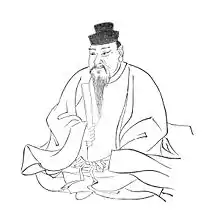Emperor Ōjin
Emperor Ōjin was the 15th emperor of Japan, according to the traditional order of succession.
| Emperor Ōjin 応神天皇 | |||||
|---|---|---|---|---|---|
 | |||||
| Emperor of Japan | |||||
| Reign | 270–310 (traditional)[1] | ||||
| Predecessor | Jingū (de facto)[lower-alpha 1] Chūai (traditional) | ||||
| Successor | Nintoku | ||||
| Born | 201[2] Umi (Fukuoka) | ||||
| Died | 310 (aged 108–109) Karushima no Toyoakira (Nara) | ||||
| Burial | Eega no Mofushi no oka no misasagi (惠我藻伏崗陵) (Osaka) | ||||
| Spouse | |||||
| Issue | See below | ||||
| |||||
| House | Imperial House of Japan | ||||
| Father | Emperor Chūai | ||||
| Mother | Empress Jingū | ||||
| Religion | Shinto | ||||
Notes
- Jingū's reign as Empress is now confined to legends rather than fact. Modern historians have labeled her as an "Empress regent", who was the de facto ruler until Homutawake (Ōjin) became emperor.
References
- "Genealogy of the Emperors of Japan" (PDF). Kunaicho.go.jp. Retrieved December 30, 2019.
- Kenneth Henshall (2013). Historical Dictionary of Japan to 1945. Scarecrow Press. p. 487. ISBN 9780810878723.
This article is issued from Wikipedia. The text is licensed under Creative Commons - Attribution - Sharealike. Additional terms may apply for the media files.